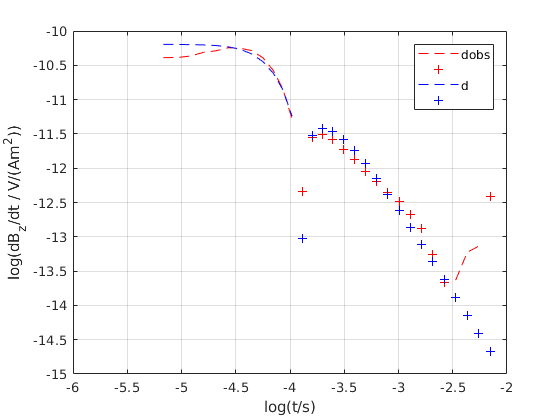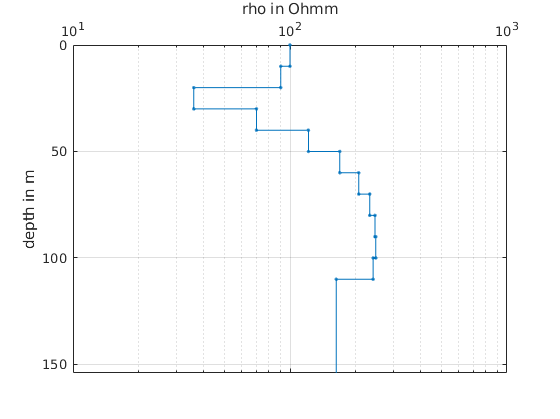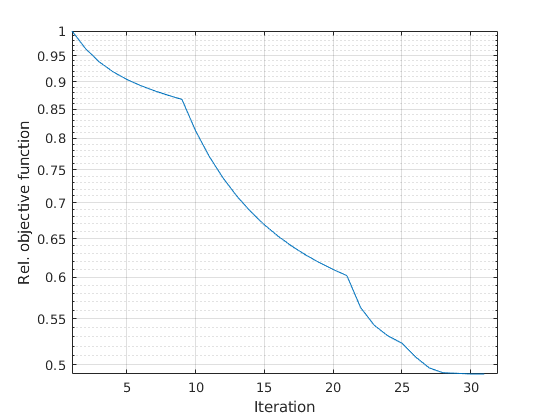This repository contains a MATLAB implementation for the one-dimensional (1-D) inversion of transient electromagnetic (TEM) data.
Data (currently
The data inversion is based on a straightforward damped Gauss-Newton approach, where the Jacobian is approximated by small perturbations of the model response.
Model parameters are the layer resistivities. Layer thickness is supposed to be fixed. Further, it is also possible to keep the resistivity of any given layer fixed.
Add installation folder to the MATLAB search path, e.g., using addpath('<path-to-folder>').
% TEMINV1D
%
% Files
% correctRampTime - add ramp time distortion to transient
% driverInversion - example driver for synthetic data
% driverPROTEM - example driver for PROTEM data
% getHankelFC - provides Fast Hankel transform coefficients
% getJ - calculate Jacobian for current model
% getVMDLayeredDownward - VMD evaluation of solution in z > 0
% getVMDLayeredHarmonic - VMD in the frequency domain
% getVMDLayeredTransient - VMD in the time domain
% getVMDLayeredUpward - VMD evaluation of layer admittances
% interp_transient - interpolate PROTEM onto log-equispaced times
% minmax - evaluate smallest and largest elements
% plot_model - plot model
% plotTransient - plot transient
% PROTEM_1D_Inversion - PROTEM_1D_Inversion inversion of PROTEM data
% simulate_PROTEM - simulatePROTEM(t, r, rho, thk, t0)
% taylortest - Taylor test for jacobian
% TEM_1D_Inversion - TEM_1D_Inversion inversion of synthetic TEM dataFunction calls to TEM_1D_Inversion and PROTEM_1D_Inversion require Parameter, Value pairs.
Both functions use the following parameter-value pairs with the associated default values:
| Parameter | Default value | Explanation |
|---|---|---|
'data' |
[] |
normalized transient data dBz/dt in |
'times' |
[] |
transient times in s |
'obs' |
[] |
transmitter-receiver offset in m |
'rho' |
[] |
starting model layer resistivities in Ohm*m |
'thickness' |
[] |
starting model layer thicknesses in m |
'fix' |
[] |
index of layer the resistivy of which is held fixed |
'lambda' |
1e2 |
initial value of regularization parameter |
'reduce_lambda' |
1e-1 |
factor by which lambda is multiplied when the relative change of the objective function between subsequent iterations drops below the value given by lambda_threshold
|
'lambda_threshold' |
3e-1 |
lambda drop tolerance, see reduce_lambda
|
'lambda_min' |
1e-12 |
least permitted value for lambda
|
'pert' |
1e-6 |
relative change in parameter when Jacobian is approximated using small perturbations |
'scale_data' |
@asinh |
function handle for transformation of data and model response |
'scale_asinh' |
1e-12 |
scaling of data when transformed by @asinh
|
'maxit' |
1e2 |
stopping criterion: maximum number of Gauss-Newton iterations |
'goal_normgc' |
1e-4 |
stopping criterion: iterate until norm of gradient drops below goal_normgc
|
'goal_objective' |
1e-8 |
stopping criterion: iterate until objective function drops below goal_objective
|
'goal_obj_diff' |
1e-5 |
stopping criterion: iterate until the difference of objective function between subsequent Gauss_Newton iterations drops below goal_objective
|
'linesearch-threshold' |
1e-6 |
search direction p can be scaled down until it drops below p * linesearch_threshold
|
'armijo_c1' |
1e-4 |
Armijo control factor: reduce step length until objective function difference is less than armijo_c1 * linesearch_step_length * directional_derivative
|
'verbose' |
true |
if true, the function generates more diagnostic output |
't0' |
0.0 |
transient ramp time provided by the PROTEM receiver (PROTEM_1D_Inversion only) |
rng('default');
% Model parameters
rho = [1000; 1000; 1000];
m = log(rho);
thk = [20 20];
% Transient times
t = logspace(-6, -3, 31);
nt = length(t);
% Observation point
r = 500.0;
% Area sinus hyperbolicus (asinh) transform with scaling
a = 1e-14;
scalefn = @(rho, a) asinh(getVMDLayeredTransient(...
[t(1) t(end)], r, rho, thk, 0.0, 1 / a));
% Generate data
dHzdt = getVMDLayeredTransient([t(1) t(end)], r, exp(m), thk, 0.0, 1.0);
% Generate random normalized perturbations
dm = rand(length(m), 1);
dm = dm ./ norm(dm);
% Step length
h = logspace(-16, -2, 43);
% Norm of zeroth and first order Taylor expansions
e0 = zeros(length(h), 1);
e1 = zeros(length(h), 1);
% Jacobian
J = getJ('data', dHzdt, ...
'rho', rho, ...
'thickness', thk, ...
'times', t,
'obs', r, ...
'pert', 1e-8, ...
'scale_data', @asinh, ...
'scale_asinh', a, ...
'protem', false);
% Loop through step length values
for k = 1:length(h)
dHzdt_p = scalefn(exp(m + h(k) * dm), a);
e0(k) = norm(dHzdt_p - asinh(dHzdt ./ a));
e1(k) = norm(dHzdt_p - asinh(dHzdt ./ a) - h(k) * J * dm);
end
% Plot
loglog(h, e0 ./ e0(end), 'bx', h, h ./ h(end), 'b--', h, e1 ./ e1(end), 'rx', h, h.^2 ./ h(end).^2, 'r--');
grid();
legend('e_0', 'O(h)', 'e_1', 'O(h^2)');
xlabel('h')
ylabel('norm of error functional')
ylim([1e-15 10])
set(gca, 'XDir', 'reverse');The evaluation of the above code should provide the following figure:
rng('default');
% Transient times
t = logspace(-6, -2, 41);
t = t(:);
% True model
rho = [100; 10; 100; 1000];
thk = [50; 10; 30];
% Observation point
r = 100.0;
% Generate data and apply Gaussian noise
dobs = getVMDLayeredTransient([t(1) t(end)], r, rho, thk, 0.0, 1.0);
dobs = dobs + t.^(0.5) .* randn(length(dobs), 1) * 1e-14;
% Starting model, 10 layers
nl = 10;
% Uniform halfspace, 100 ohm*m
rho_guess = 100 * ones(nl, 1);
% Thickness is 10 m each layer, fixed!
thk_guess = 10 * ones(nl - 1, 1);
% Fix first model parameter, i.e., resistivity of first layer
fixp = zeros(nl, 1);
fixp([1]) = 1;
% Iterate
[rho_new, obj_fn] = TEM_1D_Inversion( ...
'data', dobs, ...
'obs', r, ...
'times', t, ...
'rho', rho_guess, ...
'thickness', thk_guess, ...
'fix', fixp, ...
'scale_asinh', 1e-12, ...
'goal_obj', 1e-5, ...
'goal_obj_diff', 3e-7, ...
'lambda_min', 1e-10, ...
'pert', 1e-6, ...
'verbose', true);
% Plot true and recovered model
figure(2);
plot_model(rho, thk);
hold on
plot_model(rho_new, thk_guess);
hold off
legend('true', 'est');
xlim([1 1000]);
% Plot convergence
figure(3);
semilogy(obj_fn ./ obj_fn(1));
xlabel('Iterations');
ylabel('Rel. objective function');
grid();
xlim([1 length(obj_fn) + 1]);The evaluation of the above code should provide the following figures:
% provide field data
load data/transients_stacked.mat
records = data_stacked(ismember(data_stacked.date, '21.02.'), :);
t = records.t{1};
dobs = records.Z_field{12};
% Observation point
r = 280;
% Starting model, 12 layers
nl = 12;
rho_guess = 100 * ones(nl, 1);
thk_guess = 10 * ones(nl - 1, 1);
% Iterate
[rho_new, obj_fn] = PROTEM_1D_Inversion( ...
'data', dobs, ...
't0', 57e-6, ...
'obs', r, ...
'times', t, ...
'rho', rho_guess, ...
'thickness', thk_guess, ...
'fix', [1 0 0 0 0 0 0 0 0 0 0 0], ...
'scale_asinh', 1e-12, ...
'goal_obj', 1e-2, ...
'goal_obj_diff', 1e-4, ...
'lambda_threshold', 1e-2, ...
'verbose', true);
% Plot convergence
figure(3);
semilogy(obj_fn ./ obj_fn(1));
xlabel('Iteration');
ylabel('Rel. objective function');
grid();
xlim([1 length(obj_fn) + 1]);Again, the successful evaluation of the above code should provide figures similar to







